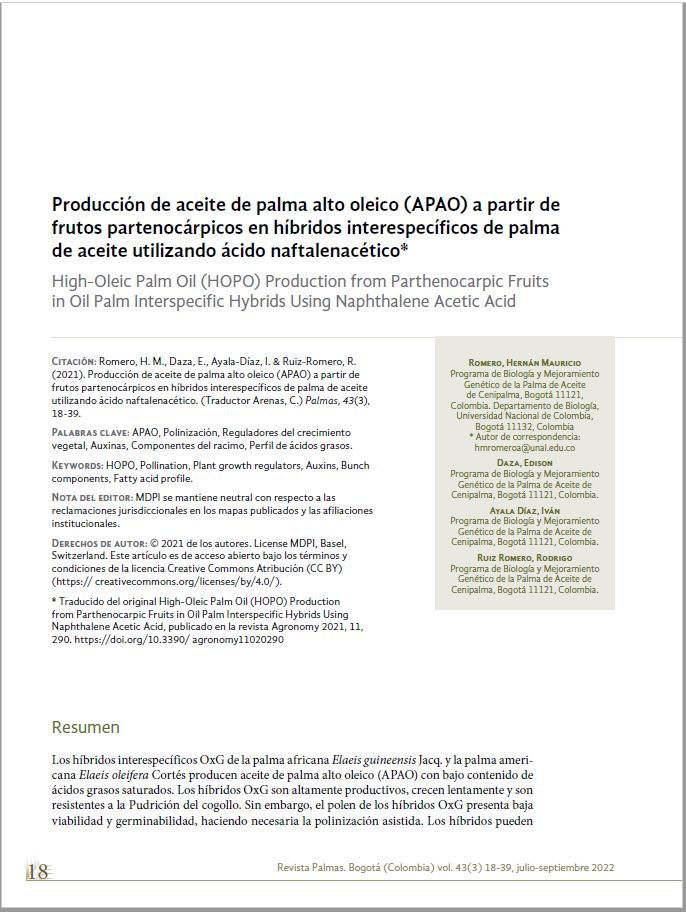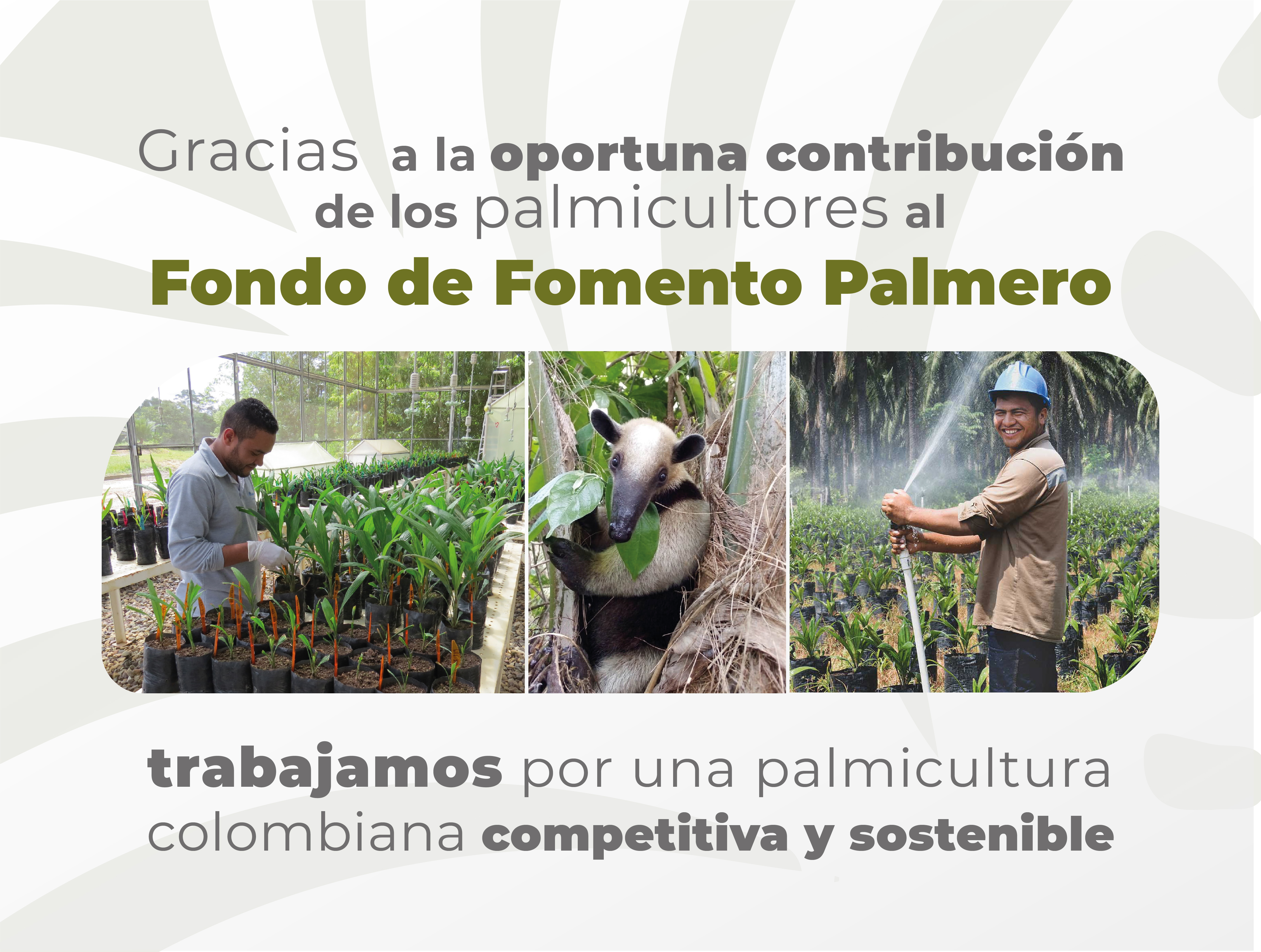Producción de aceite de palma alto oleico (APAO) a partir de frutos partenocárpicos en híbridos interespecíficos de palma de aceite utilizando ácido naftalenacético
Palabras clave:
APAO, Polinización, Reguladores del crecimiento vegetal, Auxinas, Componentes del racimo, Perfil de ácidos grasosResumen
Los híbridos interespecíficos OxG de la palma africana Elaeis guineensis Jacq. y la palma americana Elaeis oleifera Cortés producen aceite de palma alto oleico (APAO) con bajo contenido de ácidos grasos saturados. Los híbridos OxG son altamente productivos, crecen lentamente y son resistentes a la Pudrición del cogollo. Sin embargo, el polen de los híbridos OxG presenta baja viabilidad y germinabilidad, haciendo necesaria la polinización asistida. Los híbridos pueden producir frutos partenocárpicos o sin semillas con la aplicación exógena de reguladores del crecimiento vegetal. Por lo tanto, se evaluaron los efectos del ácido naftalenacético (ANA) en la inducción de frutos partenocárpicos, la formación de racimos y la calidad del aceite. Se utilizó el híbrido OxG Coari x La Mé. Se definieron las dosis, la frecuencia, el número de aplicaciones de ANA y los estadios fenológicos para los tratamientos. Una dosis total
de 1.200 mg L−1 de ANA aplicado 3 o 4 veces produjo racimos con mejor cuajado de frutos, peso promedio de racimo similar y relación aceite a mesocarpio seco que los obtenidos mediante polinización asistida. A escala semicomercial, 1.200 mg L−1 de ANA indujeron racimos que tenían un 93 % o más de frutos sin semillas.
Referencias bibliográficas
Fedepalma. Anuario estadístico 2019 La Agroindustria de la Palma de Aceite en Colombia y el Mundo 2014-2018; Federación Colombiana de Cultivadores de Palma de Aceite: Bogotá, Colombia, 2019; p. 236.
Oil World. Oil World Annual; ISTA Mielke GmBH: Hamburgo, Alemania, 2018.
Faure, J.-D.; Napier, J.A. Point of View: Europe’s first and last field trial of gene-edited plants? eLife 2018, 7, e42379. [CrossRef] [PubMed]
Mozzon, M.; Foligni, R.; Mannozzi, C. Current knowledge on interspecific hybrid palm oils as food and food Ingredient. Foods 2020, 9, 631. [CrossRef]
Rincón, S.M.; Hormaza, P.A.; Moreno, L.P.; Prada, F.; Portillo, D.J.; García, J.A.; Romero, H.M. Use of phenological stages of the fruits and physicochemical characteristics of the oil to determine the optimal harvest time of oil palm interspecific OxG hybrid fruits. Ind.Crops Prod. 2013, 49, 204-210. [CrossRef]
Mosquera-Montoya, M.; Ruiz, E.; Munévar-Martínez, D.E.; Castro, L.; Moreno, L.P.; López-Alfonso, D.F. Oil palm agroindustry 2019 production costs: A benchmarking study among companies that have adopted good practices. Rev. Palmas 2020, 41, 4-14.
Hormaza, P.; Fuquen, E.M.; Romero, H.M. Phenology of the oil palm interspecific hybrid Elaeis oleifera Elaeis guineensis. Sci. Agric. 2012, 69, 275-280. [CrossRef]
Mosquera-Montoya, M.; Ruíz-Álvarez, E.; Castros-Zamudio, L.E.; López-Alfonso, D.F.; Munévar-Martínez, D.E. Estimación del costo de producción para productores de palma de aceite de Colombia que han adoptado buenas prácticas agrícolas. Rev. Palmas 2019, 40, 3-15.
Criollo-Escobar, H.; Domínguez, J.J. Germinability and pollen viability of four improved cultivars of palm oil under laboratory conditions. Rev. Fac. Nac. Agron. Medellín 2018, 71, 8395-8405. [CrossRef]
Meléndez, M.R.; Ponce, W.P. Pollination in the oil palms Elaeis guineensis, E. oleifera and their hybrids (OxG), in tropical America. Pesqui. Agropecuaria Trop. 2016, 46, 102-110. [CrossRef]
Davies, P.J. Regulatory factors in hormone action: Level, location and signal transduction. En Plant Hormones, Revised 3rd ed.; Davies, P.J., Ed.; Springer: New York, NY, USA, 2010; pp. 16-35. [CrossRef]
Tu, D.P.; Luo, Z.L.; Wu, B.; Ma, X.J.; Shi, H.W.; Mo, C.M.; Huang, J.; Xie, W.J. Developmental, chemical and transcriptional characteristics of artificially pollinated and hormone-induced parthenocarpic fruits of Siraitia grosvenorii. RSC Adv. 2017, 7, 12419-12428. [CrossRef]
Lu, L.; Liang, J.J.; Zhu, X.; Xiao, K.; Li, T.Z.; Hu, J.F. Auxin- and cytokinin-induced berries set in grapevine partly rely on enhanced gibberellin biosynthesis. Tree Genet. Genom. 2016, 12. [CrossRef]
Tang, N.; Deng, W.; Hu, G.J.; Hu, N.; Li, Z.G. Transcriptome profiling reveals the regulatory mechanism underlying pollination dependent and parthenocarpic fruit set mainly mediated by auxin and gibberellin. PLoS ONE 2015, 10, e0125355. [CrossRef] [PubMed]
Niu, Q.F.; Wang, T.; Li, J.Z.; Yang, Q.Q.; Qian, M.J.; Teng, Y.W. Effects of exogenous application of GA(4+7) and N-(2-chloro-4pyridyl)-N’ phenylurea on induced parthenocarpy and fruit quality in Pyrus pyrifolia ‘Cuiguan’. Plant Growth Regul. 2015, 76, 251-258. [CrossRef]
Hikosaka, S.; Sugiyama, N. Effects of exogenous plant growth regulators on yield, fruit growth, and concentration of endogenous hormones in gynoecious parthenocarpic cucumber (Cucumis sativus L.). Hortic. J. 2015, 84, 342-349. [CrossRef]
Boyaci, H.F.; Oguz, A.; Yazici, K.M.; Eren, A. The efficacy of endogenous gibberellic acid for parthenocarpy in eggplant (Solanum melongena L.). Afr. J. Biotechnol. 2011, 10, 6522-6528. [CrossRef]
Subbaraya, U.; Rajendran, S.; Simeon, S.; Suthanthiram, B.; Marimuthu Somasundram, S. Unravelling the regulatory network of transcription factors in parthenocarpy. Sci. Hort. 2020, 261. [CrossRef]
McAtee, P.; Karim, S.; Schaffer, R.; David, K. A dynamic interplay between phytohormones is required for fruit development, maturation, and ripening. Front. Plant Sci. 2013, 4. [CrossRef]
Keong, W.C. Development of parthenocarpic fruits in oil palm (Elaeis guineensis Jacq.) due to application of herbicides. Planter 1987, 63, 90-95.
Thomas, R.L.; Seth, A.K.; Chan, K.W.; Ooi, S.C. Induced parthenocarpy in the oil-palm. Ann. Bot. 1973, 37, 447-452. [CrossRef]
Corley, R.H.V.; Tinker, P.B. The Oil Palm, 4th ed.; Blacwell, S., Ed.; Blacwell Science: Oxford, UK, 2003; volumen 83, pp. 221-222.
Daza, E.; Ayala-Díaz, I.; Ruíz-Romero, R.; Romero, H.M. Effect of the application of
plant hormones on the formation of parthenocarpic fruits and oil production in oil palm interspecific hybrids (Elaeis oleifera Cortés x Elaeis guineensis Jacq.). Plant Prod. Sci. 2020, 1-9. [CrossRef]
Avery Jr., G.; Berger, J.; Shalucha, B. Comparative activity of synthetic auxins and derivatives. Bot. Gaz. 1942, 104, 281-287. [CrossRef]
Aliyu, O.M.; Adeigbe, O.O.; Awopetu, J.A. Foliar application of the exogenous plant hormones at pre-blooming stage improves flowering and fruiting in cashew (Anacardium occidentale L.). J. Crop. Sci. Biotechnol. 2011, 14, 143-150. [CrossRef]
Qian, C.; Ren, N.; Wang, J.; Xu, Q.; Chen, X.; Qi, X. Effects of exogenous application of CPPU, NAA and GA4+ 7 on parthenocarpy and fruit quality in cucumber (Cucumis sativus L.). Food Chem. 2018, 243, 410-413. [CrossRef]
Hassan, J.; Miyajima, I. Induction of parthenocarpy in pointed gourd (Trichosanthes dioica Roxb.) by application of plant growth regulators. J. Hortic. Plant Res. 2019, 8, 13. [CrossRef]
Prada, F.; Romero, H.M. Muestreo y análisis de racimos en el cultivo de la palma de aceite. Tecnologías para la agroindustria de la palma de aceite, guía de facilitadores; Cenipalma: Bogota, Colombia, 2012; p. 158.
Prada, F.; Ayala-Díaz, I.M.; Delgado, W.; Ruíz-Romero, R.; Romero, H.M. Effect of fruit ripening on content and chemical composition of oil from three oil palm cultivars (Elaeis guineensis Jacq.) grown in Colombia. J. Agric. Food Chem. 2011, 59, 10136-10142. [CrossRef]
Sánchez, A.; Daza, E.; Ruiz, R.; Romero, H.M. Polinización asistida en palma de aceite. Tecnologías para la agroindustria de la palma de aceite: guía para facilitadores; Cenipalma: Bogotá, Colombia, 2011; p. 167.
Sotelo-Silveira, M.; Marsch-Martínez, N.; de Folter, S. Unraveling the signal scenario of fruit set. Planta 2014, 239, 1147-1158. [CrossRef]
Kim, J.S.; Ezura, K.; Lee, J.; Kojima, M.; Takebayashi, Y.; Sakakibara, H.; Ariizumi, T.; Ezura, H. The inhibition of SlIAA9 mimics an increase in endogenous auxin and mediates changes in auxin and gibberellin signalling during parthenocarpic fruit development in tomato. J. Plant Physiol. 2020, 252. [CrossRef] [PubMed]
Shinozaki, Y.; Beauvoit, B.P.; Takahara, M.; Hao, S.; Ezura, K.; Andrieu, M.H.; Nishida, K.; Mori, K.; Suzuki, Y.; Kuhara, S.; et al. Fruit setting rewires central metabolism via gibberellin cascades. Proc. Natl. Acad. Sci. USA 2020, 117, 23970-23981. [CrossRef]
Somyong, S.; Walayaporn, K.; Jomchai, N.; Naktang, C.; Yodyingyong, T.; Phumichai, C.; Pootakham, W.; Tangphatsornruang, S. Transcriptome analysis of oil palm inflorescences revealed candidate genes for an auxin signaling pathway involved in parthenocarpy. PeerJ
, 2018. [CrossRef]
Tranbarger, T.J.; Dussert, S.; Joet, T.; Argout, X.; Summo, M.; Champion, A.; Cros, D.; Omore, A.; Nouy, B.; Morcillo, F. Regulatory mechanisms underlying oil palm fruit mesocarp maturation, ripening, and functional specialization in lipid and carotenoid metabolism. Plant Physiol. 2011, 156, 564-584. [CrossRef]
Yeap, W.C.; Lee, F.C.; Shan, D.K.S.; Musa, H.; Appleton, D.R.; Kulaveerasingam, H. WRI1-1, ABI5, NF-YA3 and NF-YC2 increase oil biosynthesis in coordination with hormonal signaling during fruit development in oil palm. Plant J. 2017, 91, 97-113. [CrossRef] [PubMed]
Izumi, Y.; Okazawa, A.; Bamba, T.; Kobayashi, A.; Fukusaki, E. Analytica chimica acta development of a method for comprehensive and quantitative analysis of plant hormones by highly sensitive nanoflow liquid chromatography-electrospray ionization-ion trap mass
spectrometry. Anal. Chim. Acta 2009, 648, 215-225. [CrossRef] [PubMed]
Yousefi, M.; Rafie, A.S.M.; Abd Aziz, S.; Azrad, S. Introduction of current pollination techniques and factors affecting pollination effectiveness by Elaeidobius kamerunicus in oil palm plantations on regional and global scale: A review. S. Afr. J. Bot. 2020, 132, 171-179. [CrossRef]
Lucci, P.; Pacetti, D.; Frega, N.G.; Mozzon, M. Phytonutrient concentration and unsaturation of glycerides predict optimal harvest time for Elaeis oleifera × E. guineensis palm oil hybrids. Eur. J. Lipid Sci. Technol. 2015, 117, 1027-1036. [CrossRef]
Cómo citar
Descargas

Publicado
Número
Sección
Licencia

Esta obra está bajo una licencia internacional Creative Commons Atribución-NoComercial-SinDerivadas 4.0.
Métricas
| Estadísticas de artículo | |
|---|---|
| Vistas de resúmenes | |
| Vistas de PDF | |
| Descargas de PDF | |
| Vistas de HTML | |
| Otras vistas | |














